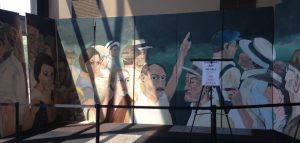Controversial Elgin artwork spurs discussions on art and race
By Jack McCarthy Chronicle Media — June 14, 2016
A controversial Elgin mural referencing a 1930s Indiana lynching has been removed and dismantled from its 10-year downtown home and is currently inside the lobby of the Hemmens Cultural Center. (Photo by Jack McCarthy/Chronicle Media)
Is there any place for a controversial Elgin mural at the intersection of art and race?
A community conversation about a 10-year-old multi-paneled outdoor mural — until recently part of the landscape of downtown Elgin — drew more than 100 persons to an insightful, civil and sometimes emotional discussion at The Centre of Elgin.
Questions raised during a nearly two-hour session ranged from how artwork displaying part of a scene from a 1930s Indiana lynching could have ever been commissioned to broader statements on state of race relations — past and present — in Elgin and America.
“When this first happened, I said I looked on this as an opportunity for us as a city to have an open, honest conversation and I hope it’s just the first one,” said Elgin Mayor David Kaptain. “I think it takes courage to sit here and talk to each other and have a conversation about race between white people and black people.”
But much of the talk from 15 speakers and audience members was that the mural — created by local artist David Powers — had no place being on prominent display.
“I feel deceived and disrespected by the city of Elgin,” one woman said. “I understand that there’s going to be art that may depict something that reflects a tough time, but you can’t tell me that if there would be a depiction of the Holocaust, that the Jewish community would be considered before it was hung.
“To rehang it at this point would be disrespectful.”
The meeting — sponsored by the city’s Human Relations Commission — was the first of two “Courageous Community Conversations” seeking input and suggestions on if and where the artwork could continue to be displayed.
The mural — entitled American Nocturne — was removed from a short pedestrian walkway and park located between Grove Avenue and Spring Street and temporarily moved to the Hemmens Cultural Center lobby.
A visitor to Hemmens last Friday found the eight panels to be part of a “temporary art install in progress” according to a sign posted near barriers. Visitors were also cautioned not to enter the area.
The artwork depicts a group of caucasian persons crowded together but looking in different directions. The central figure — a balding male with brown hair and eyes — has a raised left arm and index finger pointing to something not in the image.
The full story emerged last month when two people were struck by a similarity to portions of a photograph showing attendees at a 1930s lynching of two African-American men in Marion, Ind.
The mural does not show the bodies of the victims. But a photograph from the collection of the Indiana Historical Society offers a broader perspective, including a man pointing toward bodies of two victims hanging from trees.
News of the apparent source material for the Elgin mural exploded across social media, resulting in widespread condemnation. The city quickly removed it from the small downtown park.
Powers said in a 2007 video that the mural was “an allegory of the American Depression.”
He later said that photographs of lynchings in the 1930s influenced the artwork, according to a city of Elgin statement.
“The idea here was talking about lynching, asking questions, the history,” Powers told a local newspaper.
Not everyone was in favor placing the mural out of sight.
“It is offensive, however I’m in favor of keeping it up,” said U46 School Board member Traci O’Neal Ellis. “America has an ugly habit of sweeping our stuff under a rug. … If we keep trying to remove every symbol of the ugly past, America’s ugly history in favor of America’s exceptionalism, they will forget.
“I don’t want us to be complacent about that history.”
— Controversial Elgin artwork spurs discussions on art and race —







